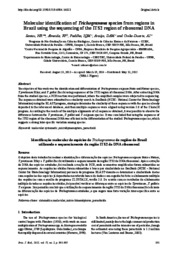Molecular identification of Trichogramma species from regions in Brazil using the sequencing of the ITS2 region of ribosomal DNA.
Molecular identification of Trichogramma species from regions in Brazil using the sequencing of the ITS2 region of ribosomal DNA.
Author(s): SANTOS, N. R.; ALMEIDA, R. P. de; PADILHA, I. Q. M.; ARAÚJO, D. A. M.; CREÃO-DUARTE, A. J.
Summary: The objective of this work was the identification and differentiation of Trichogramma exiguum Pinto and Platner species, T. pretiosum Riley, and T. galloi Zucchi using sequences of the ITS2 region of ribosomal DNA. After extracting DNA from the studied species, a PCR reaction was performed, where the amplified samples were subjected to sequencing. The sequences obtained were submitted to a similarity search in GenBank (NCBI - National Center for Biotechnology Information) using the BLAST program, aiming to determine the similarity of these sequences with the species already deposited in the referenced database, and then multiple sequences were aligned using version 2.0 of the ClustalX program. According to the results of the multiple alignments of all sequences obtained, it was possible to observe the differences between the T. pretiosum, T. galloi and T. exiguum species. It was concluded that using the sequences of the ITS2 region of the ribosomal DNA was efficient in the differentiation of the studied Trichogramma species, which suggests a strong inter-specific variation among species.
Publication year: 2015
Types of publication: Journal article
Unit: Embrapa Cotton
Keywords: DNA, DNA ribossomal, Microhymenoptera, Parasitoid, Trichogramma
Observation
Some of Embrapa's publications are published as ePub files. To read them, use or download one of the following free software options to your computer or mobile device. Android: Google Play Books; IOS: iBooks; Windows and Linux: Calibre.
Access other publications
Access the Agricultural Research Database (BDPA) to consult Embrapa's full library collection and records.
Visit Embrapa Bookstore to purchase books and other publications sold by Embrapa.

